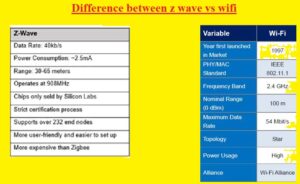 Hello readers Welcome to new post. We will discuss Difference between z wave vs wifi. These two modules are used in home automation. These modules can be configured at the electronic structure. Common installation places are security system and different samrt applications.
Hello readers Welcome to new post. We will discuss Difference between z wave vs wifi. These two modules are used in home automation. These modules can be configured at the electronic structure. Common installation places are security system and different samrt applications.
In this post we will discuss different parameters to finds their differences. So let get started Difference between z wave vs wifi
Difference between z wave vs wifi
What is WIFI
WiFi is a fast and wireless internet network used for data transfer. There are 3 main components used in this wireless technology to make WiFi fully functional.
The first component is the radio signal, the second is the antenna for transmitting and receiving the signal, and the third is the router.
The first radio network component is the main element for WiFi operation.
Computers, laptops and smart phones consist of wireless loyalty cards.
A full form of wireless fidelity uses a radio signal to process wireless high-speed internet and systems WIFI connection is established using a wireless adapter for creating hotspots.
The size of the WIFI antenna is small, so it can be placed anywhere
WIFI common applications are connected printers, laptops, computers, etc
It is compatible with 802.11 standards that allow computers and other devices to communicate.
The IEEE created the 801.11 standards that define the communication of 2 wireless devices over the air
WIFI is already built into various devices such as smartphones and handheld devices
Wifi is used in various applications of university and college offices
WiFi is a fast and wireless internet network used for data transfer. There are 3 main components used in this wireless technology to make WiFi fully functional.
The first component is the radio signal, the second is the antenna for transmitting and receiving the signal, and the third is the router.
The first radio network component is the main element for WiFi operation.
Computers, laptops and smart phones consist of wireless loyalty cards.

WIFI Working
This wireless communication technique plays an important role in the wired grounded communication system.
The actual broadcast is connected in order in detail is carried out by the technique of stereo surfing scheme, as well as the value of the wires with the monitor prone to classification.
With wireless loyalty, you can use the Internet anywhere in the designated area.
The antenna transmits a radio signal and routes data packets between computer systems.
This broadcast signal is received by a receiver installed on wifi-compatible devices such as mobile phones, laptops, smartphones, etc.
All these devices consist of a WiFi card, when they detect Wifi signals in the range of one hundred to fifty they immediately connect to the Internet.
What is Z Wave
For home automation, the Zwave protocol is used to communicate between different devices.
It offers a lower communication latency value that is accurate for small size data packets with a data rate of 100 kBits per second.
Its main activity is signal transmission and device control, and it uses a mesh topology with compatibility with thirty-two nodes.
Its working frequency is 908.42 megahertz, which varies in different countries.
It used GFSK Gaussian frequency keying of the scope and has network controller control modules and regulates the Zwave system.
Each Zwave consists of a home network ID and multiple IDS nodes for devices that are subject to regulation
The configuration of its system is simple and any user can handle it
Its structure is more expensive than Zigbee
Its operation is slower than Zigbee
It can handle 232 nodes
It can transmit data up to fifty meters
Its data rate is 9.6 to 100 kbps
It is not according to any international standard

Zwave Applications
- It used in home automation
- Used in medical instruments for measuring the fitness levels
- Used in smart energy systems
- Used for remote control of devices
- Employed in building automation






